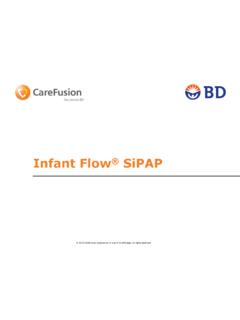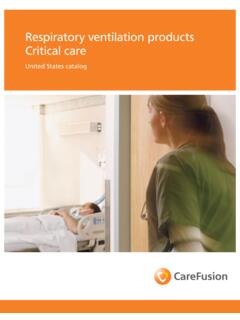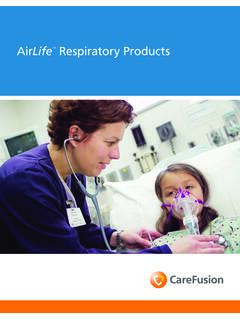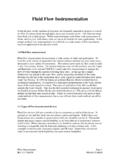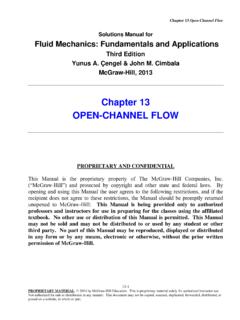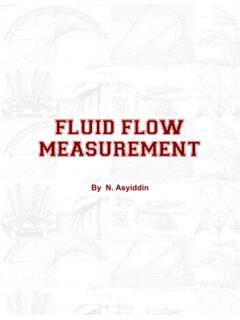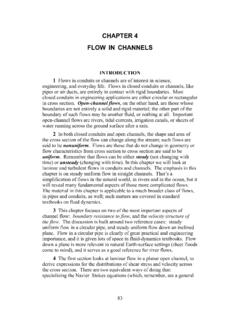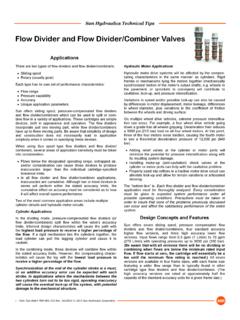Transcription of Infant Flow LP nCPAP system
1 Infant Flow LP nCPAP systemClinical training workbookInitiating and maintaining effective nCPAP therapy is a critical step in helping respiratory- compromised infants achieve successful recovery and develop normal respiratory function. When used according to your facility s treatment protocols and with this training workbook, the Infant Flow LP nCPAP system can effectively deliver nCPAP therapy to help improve patient of contentsInfant nasal CPAP ..1 6 CPAP overview ..1 3 CPAP modalities ..4 Variable flow technology ..5 Self assessment ..6 Infant Flow SiPAP driver overview ..7 16 Infant Flow LP system ..7 Infant Flow SiPAP configurations.
2 8 Infant Flow SiPAP display screen ..9 Infant Flow CPAP and circuit set-up ..10 Humidification and nCPAP ..11 Airway temperature probe placement ..11 Infant Flow SiPAP sensor calibration ..12 Infant Flow SiPAP set-up guide ..13 14 Respiratory abdominal sensor ..15 Self assessment ..16 Infant Flow SiPAP nCPAP driver ..17 22 Modes of operation ..17 18 BiPhasic mode strategy ..19 20 SiPAP exercises and self 22 Infant Flow LP generator assembly ..23 27 Infant Flow LP generator ..23 Infant Flow LP interfaces ..24 25 Infant Flow LP fixation devices ..26 Self assessment ..27 Infant Flow LP patient 46 Infant Flow LP interfaces ..28 29 Fixation devices ..30 Headgear application.
3 31 Generator assembly preparation ..32 Generator assembly and interface attachment to headgear ..33 34 Bonnet application ..35 Generator assembly and interface attachment to bonnet ..36 37 Bonnet application (alternative method 1) ..38 Bonnet application (alternative method 2) ..39 Incorrect application of fixation device and generator assembly ..40 41 Incorrect application of generator assembly and interface ..42 43 Final inspection of nasal interface placement ..44 Self assessment and return demonstration ..45 46 Routine nCPAP care ..47 49 Frequently asked questions ..50 54 Self assessment ..54 Glossary ..55 56 References ..571 Infant nasal CPAPI ntroductionWorldwide each year, approximately 15 million (1 out of every 10) babies are born Premature or low-birth weight (LBW) infants are at a high risk for respiratory problems due to underdeveloped lungs.
4 Common neonatal respiratory conditions include apnea of prematurity, respiratory distress syndrome, transient tachypnea of the newborn (TTN), meconium aspiration syndrome, pulmonary edema and post-extubation support. These conditions are often associated with decreased pulmonary compliance and functional residual capacity (FRC).1,2 Several of these infants will require respiratory support. Respiratory distress syndrome (RDS) is a condition that strains normal respiration due to the lack of natural surfactant production. Approximately 50% of neonates born at 26 to 28 weeks gestation and 30% of neonates born at 30 to 31 weeks gestation develop is surfactant?Surfactant is a phospholipid, which reduces surface tension to increase lung surfactant may be given to help reduce surface tension, increase compliance and improve ventilation.
5 Without additional respiratory assistance, many infants have difficulty establishing the adequate functional residual capacity (FRC) required to maintain normal supportSeveral options are available to help the clinician provide respiratory support to the neonatal patient. Historically, the initial treatment for infants with respiratory problems was mechanical ventilation via an artificial airway. Intubation presents a variety of challenges for any patient but compounds problems with premature infants. Given the potential complications of intubation, many physicians opt for a less invasive approach for spontaneously breathing infants that utilizes continuous positive airway pressure (CPAP).
6 As infants are preferential nose-breathers, nasal CPAP ( nCPAP ) is the preferred method for treatment delivery. CPAP enhances alveolar recruitment decreasing pulmonary vascular resistance and intrapulmonary shunting, stabilizes FRC and improves oxygenation. By increasing surface area to alveolar gas exchange, CPAP decreases V/Q mismatch. The goal of CPAP therapy is to maintain normal lung volumes and oxygenation, while enabling the Infant to breathe on their ,4 Physiologic effects of CPAP are represented in the organizational chart on page 2. CPAP overviewWhat is nasal CPAP ( nCPAP )? nCPAP is the application of positive pressure to the airways of a spontaneously breathing Infant throughout the respiratory cycle.
7 nCPAP is a continuous flow of gas administered through nasal prongs inserted in the nares or by a nasal mask placed around the perimeter of the nose. The positive pressure, usually 4 cmH2O to 8 cmH2O, acts as a splint, which can help prevent alveoli CPAP alternates between two levels of CPAP at a set time interval. The Infant can breathe at both CPAP settings. The BiPhasic mode helps increase the Infant s tidal volume and may stimulate the respiratory drive of CPAP Increases FRC Maintains and increases lung volume Improves lung compliance Reduces work of breathing (WOB) and airway resistance Provides a noninvasive procedure Allows small airways to develop Promotes the use of natural surfactant Promotes easy application Provides cost effectiveness Helps prevent extubation failure in some infants Stabilizes the airway diaphragm and chest wall Decreases incidence of chronic lung disease (CLD)2 Nasal ( nCPAP ) is associated with improved respiratory mechanics and decreased chronic lung disease (CLD)
8 Effects of nasal CPAP in neonates3 4,10 Infant nasal CPAPS plint open airwaysStretches lungand pleuraStimulates lung growthStimulates theJ receptors and HIBRS tabilizes chest wall and diaphragmIncreases pharyngealcross sectionRecruits alveoli and preventsalveoli collapseIncreases FRCand lung volumesImproves V/Q ratio and increasesoxygenationDecreases WOBD ecreasesobstructive apneaDecreasesintrapulmonaryshuntingImpr oves V/Q ratioConservessurfactantMaintains airwaypatencyReduces upperairway resistanceImproves breathing patternand decreases WOBR educes centralandobstructive apneaIndications for use2 5 Abnormalities on physical examination- Increased WOB- Increased respiratory rate- Intercostal and substernal
9 Recession- Grunting and nasal flaring- Pale skin color- Restlessness Deteriorating arterial/capillary blood gas values ( , hypercapnea) Increased oxygen requirements to maintain a SaO2 greater than 92% with FiO2 > 60% Atelectasis and infiltration Clinical conditions- Apnea of prematurity- Chest infections ( , pneumonia)- Transient tachypnea of the newborn (TTN)- Mild meconium aspiration Weaning/Post-extubation supportContraindications for use2 5 Severe cardiovascular instability Respiratory failure defined as pH < and PaCO2 > 60 mmHg torr Congenital malformations of the upper airway (cleft palate, choanal atresia or tracheoesophageal fistula) Congenital diaphragmatic hernia or untreated bowel obstruction Poor respiratory drive unresponsive to CPAP therapy (frequent apnea episodes associated with oxygen desaturation and/or bradycardia)What is work of breathing?
10 WOB describes the amount of effort required to breathe. Any therapy that introduces incoming pressure to a patient s respiratory system potentially adds imposed WOB. Infants with RDS experience elevated WOB levels, and by expending additional effort to inhale and exhale against pressurized gas, the Infant consumes precious calories overcoming the high WOB level. These calories could otherwise be spent on vital recovery and growth processes. In addition to helping the Infant conserve energy, a WOB reduction may reduce stress and anxiety necrosisNasal dilationPotential problems associated with CPAP therapy3,5,6 Clinicians should be aware of the possible hazards and complications associated with CPAP, and take the necessary precautions to ensure safe and effective applications, such as.
